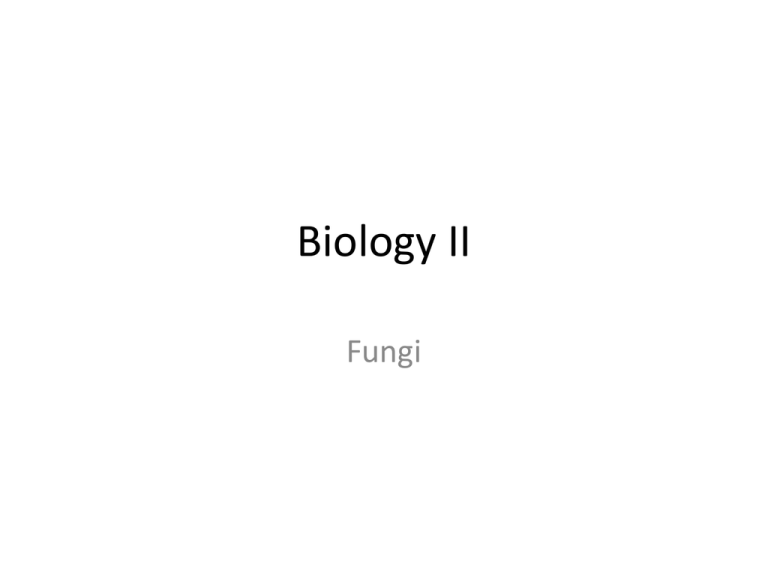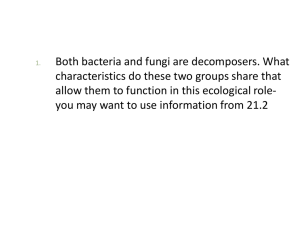Biology II
advertisement

Biology II Fungi Introduction of Fungi • They are classified as eukaryotes (have a membrane bound nucleus) • Fungi can be divided into two basic morphological forms: – Yeasts – Hyphae Yeast • Unicellular fungi • Reproduce asexually by blastoconidia formation (budding) or fission Hyphae • Multicellular • Reproduce asexually and/or sexually • Most Fungi occur in the hyphae form as branching, threadlike tubular filaments – Lack cross walls (coenocytic) – Have cross walls (septate) – Clamp connections at the septa which connect the hyphae elements Common Characteristics of Fungi • Heterotrophy-eat other organisms as food – Three major categories of heterotrophs • Saprophytes-Feed on dead tissue or organic waste • Symbionts- mutually beneficial relationship between a fungus and another organism • Parasites- feeding on living tissue of a host – Parasites that cause diseases are called pathogens – Some parasites are obligate parasites (require a living host) – Others are facultative or nonobligate (do not require a living host in order to survive) Common Characteristics • Body Form – Unicellular – Filamentous-tube-like strands called hypha or hyphae – Mycelium- total of hyphae – Sclerotium=Hardened mass of mycelium that generally serves as an overwintering stage – Multicellular-such as mycelial cords, rhizomorphs, and fruit bodies (mushrooms) Common Characteristics • Fungus is often hidden from view – It grows through its food source, excretes extracellular digestive enzymes, and absorbs dissolved food • Indeterminate growth Common Characteristics • Spores- asexual (product of mitosis) or sexual (product of meiosis) in origin – Purpose of Spores • Allows the fungus to move to new food source • Resistant stage- allows fungus to survive periods od adversity • Means of introducing new genetic combinations into a population Common Characteristics • Vegetative phase of fungus is generally sedentary • Cell wall present, composed of cellulose and/or chitin • Food Storage- generally in the form of lipids and glycogen • Eukaryotes-true nucleus and other organelles present Common Characteristics • All fungi require water and oxygen • Fungi grow in almost every habitat imaginable, as long as there is some type of organic mater present and the environment is not too extreme • Diverse group, number of describer species is about 69,000 (estimated 1.5 million species total) Phylums of Fungi • Phylum Zygomycota- common mold found on land – Reproduce by zygospores – Ex: Rhizopus- common bread mold – Contain root-like structures (rhizoids) to anchor in bread. Stolons on surface of bread. Phylum Basidiomycota • Basidiomycetes- the club fungi, about 22,300 species • Includes mushrooms, toadstools, puffballs, shelf fungi, rusts, bird’s nest fungi and smuts • Characterized by perforate septate hypahe and the production of basidium (club) following sexual reproduction.


